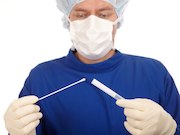Decrease in 5-year ≥CIN3 risks after each successive negative round of HPV, cytology co-testing
TUESDAY, Nov. 28, 2017 (HealthDay News) — The five-year risks of cervical intraepithelial neoplasia grade 3 (CIN3), adenocarcinoma in situ, and cervical cancer (≥CIN3) decrease after each successive negative human papillomavirus (HPV) and cytology co-testing, according to a study published online Nov. 27 in the Annals of Internal Medicine.
Philip E. Castle, Ph.D., M.P.H., from the Albert Einstein College of Medicine in Bronx, N.Y., and colleagues conducted an observational cohort study involving 990,013 women who had one or more co-tests from 2003 to 2014. The authors examined the three- and five-year cumulative detection of ≥CIN3.
The researchers observed a decrease in five-year ≥CIN3 risks after each successive negative co-test screening round (0.098, 0.052, and 0.035 percent for first, second, and third co-test, respectively). Regardless of the cytology result, five-year ≥CIN3 risks for an HPV-negative co-test nearly matched the performance of a negative co-test for each successive round of screening (0.114, 0.061, and 0041 percent, respectively). For the cytology-negative co-test, ≥CIN3 risks also decreased with each successive round, regardless of the HPV result, but the three-year risks were as high as five-year risks after an HPV-negative co-test (0.199, 0.065, and 0.043 percent, respectively). After the second negative co-test, no interval cervical cancer cases were diagnosed.
“After one or more negative cervical co-tests (or HPV tests), longer screening intervals (every five years or more) might be feasible and safe,” the authors write.
Several authors disclosed financial ties to the pharmaceutical industry.
Copyright © 2017 HealthDay. All rights reserved.








